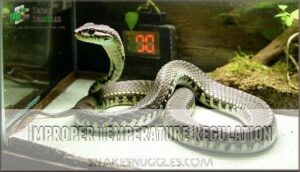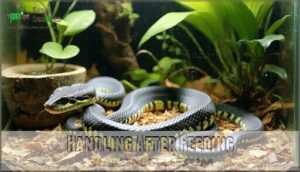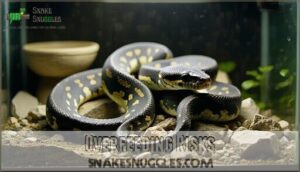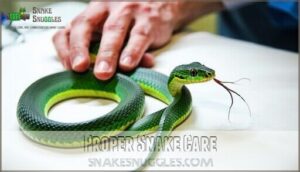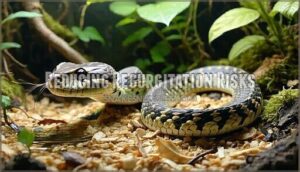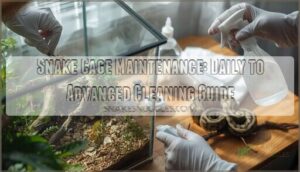This site is supported by our readers. We may earn a commission, at no cost to you, if you purchase through links.

Don’t handle your snake for 48-72 hours after feeding – this stress-free period lets them digest peacefully.
Feed appropriately-sized prey items that create only a slight bulge when swallowed, and stick to consistent feeding schedules rather than overfeeding.
Keep humidity levels stable and provide fresh water for proper hydration.
Monitor for signs of illness like mites or respiratory infections that can disrupt digestion.
Creating the right environment is like setting up a five-star digestive spa for your scaly friend, but there’s more to mastering this delicate balance.
Table Of Contents
- Key Takeaways
- Snake Vomiting Causes
- Prevent Snake Vomiting
- Proper Snake Care
- Reducing Regurgitation Risks
- Maintaining Snake Health
- Frequently Asked Questions (FAQs)
- Why does my snake keep vomiting?
- How to prevent snake regurgitation?
- How long to wait after snake regurgitates?
- What to do if my ball python regurgitates food?
- Why does my snake keep throwing up?
- Do snakes vomit when stressed?
- What to do if your ball python regurgitates?
- Why does my snake throw up clear liquid?
- How often should I clean my snakes enclosure?
- Can I feed my snake more than one prey item?
- Conclusion
Key Takeaways
- Maintain proper temperatures between 78-92°F with a thermal gradient – cold conditions slow digestion and trigger regurgitation within 24-48 hours
- Don’t handle your snake for 48-72 hours after feeding – this stress-free period lets them digest peacefully without forced vomiting
- Feed appropriately-sized prey that matches your snake’s thickest body section – oversized meals exceed their regurgitation threshold and force rejection
- Keep humidity stable at 50-60% and provide fresh water weekly – proper hydration supports digestion while preventing dehydration-related vomiting
Snake Vomiting Causes
You’ll encounter snake vomiting when key factors go wrong in their care routine.
Understanding temperature control, feeding timing, meal proportions, and frequency helps you create conditions that keep your snake’s digestive system running smoothly.
Improper Temperature Regulation
Extreme temperature fluctuations can wreak havoc on your snake’s digestive system.
Temperature swings destroy your snake’s ability to digest food properly.
Without proper thermal gradient and basking spot maintenance, your snake’s metabolism slows dramatically, preventing normal digestion.
Cold nighttime drops below species requirements trigger regurgitation within 24-48 hours.
Overfeeding can also lead to issues, so avoid prey that exceeds the snake’s head diameter to prevent common snake regurgitation.
Effective heating methods and consistent temperature monitoring are essential for snake health and preventing digestive complications.
Handling After Feeding
Handling your snake right after feeding dramatically increases vomiting risks.
You’ll trigger snake regurgitation if you pick up your pet within 48-72 hours post-meal.
Gentle handling requires patience – wait until digestion completes.
Minimal stress means avoiding agitation during this critical window.
Post-meal observation from outside their safe enclosure prevents unnecessary disturbance.
Proper feeding includes respecting your snake’s digestive process completely.
Handling too soon can disrupt their snake digestion process, which is a critical aspect of snake care and understanding the snake’s digestive system.
Incorrect Meal Size
With incorrect meal size, you’re walking a tightrope between feast and famine.
Prey that’s too large exceeds your snake’s regurgitation threshold, forcing their body to reject the meal entirely.
Undersized prey issues create different problems – your snake might overeat multiple small items, disrupting their natural feeding schedule effects.
Both scenarios prevent snake vomiting through proper portion control.
Follow prey size guidelines matching your snake’s widest body section for ideal snake digestion and diet success.
Overfeeding Risks
Overfeeding creates serious health risks that can permanently damage your snake’s well-being.
Overfeeding your snake isn’t just a mistake—it’s a path to permanent health damage.
Obesity dangers include organ damage and reduced lifespan, while metabolic issues disrupt normal body functions.
Consistent feeding schedules prevent snake vomiting by maintaining proper digestion.
Large meals strain your snake’s system, causing regurgitation and long-term health problems.
Following established snake diet guidelines and understanding regurgitation causes helps maintain ideal snake husbandry for your pet’s longevity and overall well-being.
Prevent Snake Vomiting
Three key strategies will dramatically reduce your snake’s vomiting episodes and keep them healthy.
Start with Dietary Adjustments by feeding appropriately-sized prey items—nothing wider than your snake’s thickest body section.
Stress reduction plays a vital role in preventing regurgitation causes, so maintain consistent temperatures and avoid handling snakes for 48-72 hours after feeding.
Here’s your prevention roadmap:
- Master Handling Techniques – Wait until digestion completes before any interaction
- Ensure Enclosure Security – Stable temperatures prevent digestive disruptions
- Monitor Hydration Importance – Fresh water supports proper snake diet processing
- Address Shedding Problems – Humidity issues can trigger stress-related vomiting
Proper snake husbandry means understanding that your pet’s digestive system works differently than mammals.
Temperature fluctuations can halt digestion mid-process, forcing regurgitation.
Think of it like trying to cook dinner while someone keeps adjusting your oven—nothing turns out right.
Proper Snake Care
You’ll substantially reduce regurgitation episodes when you master the fundamentals of proper snake husbandry and feeding protocols.
Understanding your snake’s specific digestive requirements and environmental needs creates the foundation for preventing vomiting incidents that can compromise their health and recovery, based on fundamentals of care.
Prey Item Sizing
Choose prey items that match your snake’s body thickness at its widest point.
Appropriate Size matters—food that’s too large causes regurgitation, while undersized meals don’t provide adequate nutrition.
Prey Weight should equal 10-15% of your snake’s body weight.
Understanding appropriate rodent sizes is vital for successful feeding.
Younger snakes need smaller, more frequent meals than adults.
Multiple Prey items work better than one oversized piece for efficient digestion and reptile health tips.
Appropriate Size is crucial, and prey items should be chosen based on this principle to avoid issues such as regurgitation.
Digestive Challenges
Your snake’s gut microbiome plays a pivotal role in breaking down prey, but enzyme deficiencies can create serious digestive challenges.
Poor hydration impacts nutrient absorption, while metabolic disorders slow digestion considerably.
Watch for impaction risks when feeding oversized meals.
These common snake problems require immediate attention from reptile health professionals.
Snake illness often stems from digestive imbalances, making proper snake care essential for preventing veterinary emergencies, and addressing metabolic disorders is crucial.
Addressing Infections
Bacterial and parasitic infections can trigger severe vomiting episodes in your snake.
You’ll need to identify pathogens through veterinary care and fecal testing.
Implementing strict hygiene protocols and quarantine procedures for new snakes prevents disease spread.
When snake illness occurs, antibiotic use under professional guidance addresses bacterial infections effectively.
Preventative measures include maintaining clean enclosures and regular health screenings.
These common snake problems require immediate attention from reptile veterinarians.
Your snake care guide should emphasize early intervention to prevent complications and guarantee proper treatment protocols for successful recovery outcomes.
Snakes can also suffer from infectious stomatitis, also known as mouth rot.
Providing Adequate Soaking
After treating bacterial infections, proper hydration remains essential for recovery.
You’ll want to provide a shallow soaking dish that’s roughly one-third your snake’s body width.
Fresh water should be changed weekly or when contaminated.
Hydration Importance can’t be overstated during shedding cycles when Skin Health depends on adequate moisture.
Proper Humidity levels combined with regular Soaking Frequency will prevent dehydration-related vomiting while supporting natural snake behavior and overall reptile care success.
Reducing Regurgitation Risks
You can dramatically reduce your snake’s regurgitation risks by monitoring four critical areas: feeding frequency, overall health status, parasite presence, and veterinary care.
Smart snake owners know that preventing vomiting starts with understanding your pet’s digestive limits and recognizing early warning signs before they become serious health issues.
Avoiding Overfeeding
Feeding your snake too much can trigger vomiting episodes that stress both you and your pet.
Establish a consistent feeding schedule with appropriately sized prey items to prevent overfeeding complications.
Adult snakes typically eat every 1-2 weeks, while juveniles need more frequent meals.
Monitor portion control carefully – prey should match your snake’s thickest body section.
Proper digestion time between meals reduces obesity risks and supports healthy reptile care practices.
Monitoring Health
Regular health monitoring helps you catch problems before they become serious issues.
Watch for behavior changes like decreased activity or unusual hiding patterns.
Check essential signs during routine handling – note any weight fluctuations or shedding issues that seem abnormal.
Keep detailed records of feeding schedules and fecal analysis results.
Your reptile owner advice should include proper enclosure setup with consistent temperature control to prevent disease outbreaks, ensuring a healthy environment through consistent temperature control.
Identifying Parasitic Infections
Parasite identification starts with watching for infection symptoms like changes in feeding patterns or unusual fecal consistency.
Fecal exams reveal common parasites that cause disease in snakes.
Regular health monitoring helps you spot parasitic infections early, while preventative measures can prevent serious digestive issues from developing.
Consulting Reptile Veterinarian
Veterinarian Expertise becomes essential when your snake shows persistent regurgitation patterns.
A reptile specialist can perform Diagnostic Procedures to identify underlying disease causes that standard medicine might miss.
These professionals offer Specialized Care through targeted Treatment Options, helping prevent future episodes.
Don’t wait—Preventative Healthcare consultations can catch problems early, saving your snake from serious complications.
Regular check-ups are essential for early disease detection.
Maintaining Snake Health
You’ll need to master four key areas to keep your snake healthy and prevent vomiting episodes.
These essential practices work together to create the ideal conditions your snake needs to thrive and digest food properly, which are complete concepts that help ensure your snake’s overall health.
Correct Feeding Techniques
You’ll prevent feeding problems by mastering proper techniques.
Feeding frequency matters – adults eat every 2-3 weeks, while juveniles need weekly meals.
Prey variety isn’t necessary since snakes thrive on consistent food sources.
Food preparation involves thawing frozen prey completely and warming it to body temperature.
Supplementation needs are minimal with whole prey feeding.
Hydration importance can’t be overstated – fresh water prevents dehydration-related digestive issues, ensuring snakes receive the care they need for optimal health with minimal supplementation.
Recognizing Digestive Issues
Understanding your snake’s digestive health starts with watching for Early Symptoms that signal trouble ahead.
Appetite Loss often appears first, followed by visible Behavior Changes like lethargy or unusual positioning.
Monitor these warning signs closely:
- Swollen, reddened mouth tissues indicating internal distress
- Mid-body swelling from thickened stomach muscles
- Small purplish-red spots appearing on skin surface
Fecal Analysis helps identify parasitic infections, while checking Hydration Levels can prevent serious complications from succeeding, which is crucial for maintaining overall digestive health.
Preventing Stress
Stressful situations can trigger vomiting in snakes, making stress management essential for their digestive health.
You’ll need to implement specific strategies to create a calm environment that supports proper digestion. Regular wellness exams can also help detect underlying issues early.
| Stress Factor | Prevention Measures |
|---|---|
| Enclosure Security | Provide hiding spots and secure lid |
| Handling Frequency | Limit to feeding and cleaning only |
| Habitat Enrichment | Add branches, plants, varied textures |
| Shedding Stress | Increase humidity, avoid disturbance |
| Brumation Management | Maintain consistent temperature cycles |
These strategies help prevent stress-related regurgitation and keep your snake healthy.
Ensuring Proper Environment
Your snake’s home makes or breaks their digestive health. Create a proper thermal gradient with basking spots at 88-92°F and cool areas around 78-80°F.
Maintain humidity control between 50-60% using a reliable hygrometer. Choose appropriate enclosure size – at least 40 gallons for adult ball pythons.
Provide multiple hiding spots and select digestible substrate. Proper setup of a snake’s living space is critical.
These precautionary measures prevent vomiting by supporting natural digestive processes through ideal environmental care, ensuring a healthy and thriving snake’s home.
Frequently Asked Questions (FAQs)
Why does my snake keep vomiting?
Like troubleshooting a medieval printing press, your snake’s regurgitation stems from stress, improper temperatures, handling too soon after feeding, oversized prey, or illness requiring veterinary attention.
How to prevent snake regurgitation?
Keep your snake’s environment stress-free with proper temperatures, humidity, and hiding spots. Don’t handle them after feeding, maintain consistent schedules, and make certain prey size matches your snake’s girth appropriately.
How long to wait after snake regurgitates?
Wait 2-3 weeks before feeding your snake after regurgitation. This gives their digestive system time to fully recover and prevents additional stress that could trigger another episode.
What to do if my ball python regurgitates food?
Stop feeding immediately and wait 2-3 weeks before offering food again. Handle minimally, maintain proper temperatures, and make certain prey size isn’t too large. Consider veterinary consultation if regurgitation continues.
Why does my snake keep throwing up?
Notably, snakes and humans share similar digestive sensitivities.
Your snake’s regurgitation likely stems from stress, improper temperatures, handling too soon after feeding, or prey that’s too large.
Check your husbandry conditions first.
Do snakes vomit when stressed?
Yes, snakes definitely vomit when stressed.
Stress triggers their digestive system to shut down, causing them to regurgitate food.
You’ll often see this happen after handling, environmental changes, or temperature fluctuations that make your snake uncomfortable.
This behavior is a natural response to stress.
What to do if your ball python regurgitates?
If your ball python regurgitates, it’s absolutely vital you don’t panic! Immediately remove uneaten food, don’t handle for two weeks, maintain proper temperatures, and wait before offering smaller prey items.
Why does my snake throw up clear liquid?
Your snake’s vomiting clear liquid typically indicates stress, improper temperatures, overhandling, or illness.
Check that your terrarium maintains proper heat gradients and humidity levels.
Avoid handling for several days after feeding, and consult a reptile veterinarian if vomiting continues.
How often should I clean my snakes enclosure?
You’ll want to tidy up your scaly friend’s home spot-on every two to four weeks, depending on humidity and waste frequency.
Clean water bowls weekly, remove uneaten food immediately, and spot-clean messes as they happen.
Can I feed my snake more than one prey item?
You can feed multiple prey items to your snake, but it’s typically better to offer one appropriately-sized prey item per feeding.
Multiple smaller items increase handling stress and digestion workload for your snake.
Conclusion
Like a well-tuned engine that runs smoothly with proper maintenance, learning how to prevent snakes from vomiting requires consistent attention to their care requirements.
You’ve now got the essential knowledge to keep your snake healthy and comfortable.
Remember that proper temperatures, appropriate feeding schedules, and stress-free handling are your most powerful tools.
Monitor your snake’s behavior regularly, maintain stable environmental conditions, and don’t hesitate to consult a reptile veterinarian when concerns arise.
Your dedication to these practices will guarantee your snake thrives.
- https://familysnake.com/guides/handling-hissy-fits-managing-regurgitation-in-your-pet-snake/
- https://www.msdvetmanual.com/all-other-pets/reptiles/disorders-and-diseases-of-reptiles
- https://www.merckvetmanual.com/all-other-pets/reptiles/disorders-and-diseases-of-reptiles
- https://www.cdc.gov/healthy-pets/about/reptiles-and-amphibians.html
- https://www.petmojo.com/cryptosporidiosis-pet-reptiles-symptoms-prevention-treatment/

